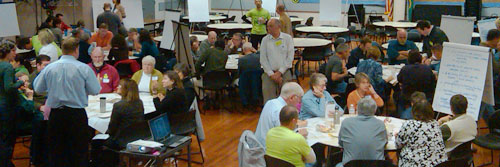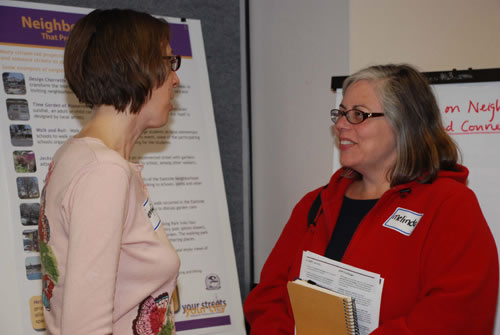Public Participation and Partners Revised 11/21

Community members talk about their priorities at an Imagine Olympia event
What Olympia Values:
Olympians value their right to participate in city government, and to engage in meaningful, open and respectful community dialogue regarding decisions that affect our community.
Our Vision for the Future:
Through collaborative and open discussions, Olympians embrace a shared responsibility to make our community a better place.
Read more in the Community Values and Vision chapter
Introduction
Successful communities face their challenges collectively and harness the energy of different stakeholders. Without diverse participation in community decision-making, it is all too easy to descend into political gridlock over difficult problems.
The voices of residents, local business owners and organizations provide the perspective and information that are absolutely essential to effective planning and decision-making regarding issues that will shape our community for generations to come. For this reason, the City has a strong, ongoing program to reach out and partner with all sectors of the community.
The City has found cooperative relationships between members of the community and policy-makers that will continue to be essential if we are to achieve the collective vision and goals described in this Plan. It understands and makes use of effective and tested methods for encouraging community members to engage at multiple levels as we continue to look for creative solutions to the challenges we all share.

A young child enjoys a beautiful day in Olympia.
Public Participation is Essential
Active participation in civic affairs is an important part of life in Olympia, and the City has a long history of providing a forum for community members to get involved. Our open government policies are essential to ensure residents, business owners, employees and other community members are able to effectively participate in any number of issues.

Young people having fun at a community event.
There are several ways to participate in local government planning and decision-making in Olympia:
• Run for City Council or vote in the election
• Serve on an advisory board. Olympia has several volunteer citizen advisory boards that study critical issues and provide careful advice to the City Council
• Testify at a public hearing, share your opinion in a letter, or participate in a community workshop or meeting. The City keeps a calendar and posts online agendas of such events
• Volunteer in one of many City programs aimed at helping the community help itself, such as Stream Team, Volunteers in Police Services and Volunteers in Parks
• Get involved with neighborhood programs. The City provides notification of certain development proposals, grant opportunities and other benefits to Recognized Neighborhood Associations (RNA) and the Council of Neighborhood Associations (CNA)
• Partner with the City to help implement the Comprehensive Plan. The City looks for partners from all sectors of the community to be involved in implementation through “Imagine Olympia, Take Action”
• Participate in planning for a “sub-area” that could include your own neighborhood. As Olympia grows and changes, the City will be collaborating with local residents and business owners to make key planning decisions on roads, walkways, bike paths, housing densities, and transit – to name a few.
Public outreach is essential, but also challenging. Some key challenges include:
• Our population is more diverse than ever, but our outreach resources are limited.
• Our desire to be responsive to community concerns must be balanced with very real legal and fiscal constraints, finite resources, and with our responsibility to make decisions for the overall public good, rather than for the benefit of individuals.
• Residents, business owners, and local organizations need to understand the land-use development process so they can be involved in a meaningful way.
To address these challenges, the City is always looking for new and creative ways to engage the community, including using new technologies, such as social media, online discussion portals and high-quality visual maps. The City strives to create clear, concise and jargon-free information so that people from all walks of life can easily and quickly understand the issues and provide input. The City hopes this will inspire partnerships that will help the community to pool its resources so that needed changes can be made more quickly and efficiently.
While Olympians are involved in all aspects community planning, the land development process is often where neighborhood organizations and community members first engage. The experience tends to be frustrating because influence over decisions at this stage is somewhat limited. The City’s intent in initiating sub-area planning is to give community members a chance to get involved early in the planning process for a relatively small area that includes their own neighborhood. Many communities refer to this type of planning process as "neighborhood planning." To avoid confusion with Olympia’s numerous Recognized Neighborhood Associations, the City refers to the process as "sub-area planning."
Through sub-area planning, the City and Coalition of Neighborhood Associations work with stakeholders to identify neighborhood assets, challenges and priorities for development. Activities are geared toward learning; for the City to learn about neighborhood needs and desires, and for these groups to learn about the plans and regulations that guide development in their area; and how land use decisions also must comply with federal, state and local laws. Although this process does not guarantee a neighborhood will get everything it wants, sub-area planning can help it get organized for future projects that will influence the direction of community decisions.

A community member discusses neighborhood issues with City staff at a public meeting.
Goals and Policies
The City, individual community members, other agencies and organizations all have a role in helping accomplish the vision and goals of the Comprehensive Plan.
PP1.1Develop a strategy to implement the Comprehensive Plan goals and policies. Collaborate with partners, including City Advisory Committees and Commissions, neighborhoods, and other community groups, so that the strategy reflects community priorities and actions.
PP1.2Annually measure and highlight progress towards achieving the Comprehensive Plan goals and policies. Engage the community in updating the strategy, publish performance reports, and recognize community partners who contribute to achieving the vision.
PP1.3As the action plan is developed and carried-out, the City will provide education, technical assistance, volunteer opportunities and other methods to include the community in this work.
People of all ages, backgrounds and physical abilities can access public meetings and information.
PP2.1Make information and outreach materials available through a variety of means.
PP2.2Use and consistently evaluate new technologies to improve ways for community members to receive information and provide input.
PP2.3Evaluate and pursue creative methods to inform and engage community members and under-represented groups who may not ordinarily get involved in civic affairs.GP3
PP3.1Support and encourage City staff and other community leaders to strengthen their capacity to design and implement effective public involvement strategies.
PP3.2Help the general public understand the structure of local government, how decisions are made, and how they can become involved.
PP3.3Give community members, neighborhoods, and other interested parties opportunities to get involved early in land use decision-making processes. Encourage or require applicants to meet with affected community members and organizations.
PP3.4Create structured opportunities for people to learn about city issues, share their experiences and motivations, and discuss public issues productively.
PP3.5Develop public participation plans when amending or updating the Comprehensive Plan or master plans. Develop public participation or communication plans for other major projects.
PP3.6Amend the Comprehensive Plan each year to incorporate the updated Capital Facilities Element and act upon other proposed changes to the Plan. Adopt these amendments only after notifying the public and providing opportunities for public comment.
PP3.7Seek input from the community, including neighborhood associations and other groups, before final decisions are made to site public and private utility facilities, especially when they may have a significant impact.
PP3.8Respect property owners’ legal rights when implementing this plan. Regulations should provide for compensation for the property owner or waivers from requirements if the implementation of the regulation would otherwise constitute a legally defined ”taking.”
PP3.9Adopt a moratorium or interim zoning control only in cases of an emergency as defined by State statute.
Community members and other key stakeholders feel their opinions and ideas are heard, valued, and used by policy makers, advisory committees, and staff.
PP4.1Build trust among all segments of the community through collaborative and inclusive decision making.
PP4.2Replace or complement the three-minute, one-way testimony format with an approach that allows meaningful dialogue between and among community members, stakeholders, City Council members, advisory boards, and staff.
PP4.3Clearly define public participation goals and choose strategies specifically designed to meet those goals.
PP4.4Evaluate public participation strategies to measure their effectiveness in meeting desired goals.
PP4.5Select strategies from the full spectrum of public participation tools and techniques.
Sub-area planning is conducted through a collaborative effort by community members and the City, and is used to shape how neighborhoods grow and develop.
PP5.1Work with neighborhoods to identify the priorities, assets and challenges of designated sub-area(s), as well as provide information to increase understanding of land-use decision-making processes and the existing plans and regulations that could affect them.
PP5.2Encourage wide participation in the development and implementation of sub-area plans.
PP5.3Define the role that sub-area plans play in City decision-making and resource allocation.
PP5.4Allow initiation of sub-area planning by either neighborhoods or the City.
PP5.5Encourage collaboration between neighborhoods and City representatives.
Our Partners: Strong Interjurisdictional Partnerships Help Our Region Thrive
Our City has strong planning partnerships with other area jurisdictions, and these have helped our region thrive. The Thurston Regional Planning Council (TRPC), plays an important role in fostering this collaboration. TRPC consists of decision makers from numerous jurisdictions and organizations in Thurston County who meet regularly to discuss important regional issues. They also prepare a variety of plans and studies on environmental quality, land use and transportation, demographic trends, and other issues – all of which provide a framework for making informed decisions. Its work has influenced many parts of this Plan.
Because the City recognizes that our community is affected by forces outside our jurisdictional borders, we regularly coordinate with Thurston County and its other cities. We share County-Wide Planning Policies, which ensure our comprehensive plans are coordinated and consistent. These policies express shared regional goals to:
• Improve livability
• Preserve and enhance the quality of our environment
• Preserve open spaces
• Offer varied and affordable housing
• Provide high-quality urban services at the lowest possible cost
• Plan for development in the urban growth area so that upon annexation, these areas transition from the county to cities (from rural to urban) in an organized way

Kids plant a tree sapling at a local park.
In addition to our County-Wide Planning Policies, the cities of Olympia, Lacey and Tumwater work with Thurston County to establish and periodically review Urban Growth Areas, where high density, urban growth is encouraged (See Land Use and Design chapter.)
Olympia’s Urban Growth Area includes areas in unincorporated Thurston County the City expects to eventually annex. For this reason, it’s important for the City of Olympia and Thurston County to establish common zoning and development regulations for these areas and avoid annexations that create illogical boundaries, which increase the cost of city services. The City and County periodically review the Urban Growth Boundary to get an accurate picture of future urban development.
Because this Plan applies, in part, to unincorporated Thurston County lands, it guides Thurston County decisions within Olympia Urban Growth Areas. The parts of this Plan that apply to these overlapping areas are often referred to as the "Joint Plan" for Olympia’s Urban Growth Area and are also part of the Thurston County Comprehensive Plan.
The City also works closely with policy-makers from the State of Washington, Port of Olympia, Olympia School District and other jurisdictions to share information and collaborate when public resources can be pooled.
The goals and policies below relate to partnerships focused on growth management.
Goals and Policies
Olympia accommodates growth in a way consistent with the regional goals expressed in County-Wide Planning Policies.
PP6.1Cooperate with Thurston County and its other municipalities to ensure comprehensive plans are coordinated and consistent.
PP6.2Cooperate with Thurston County and the cities of Lacey and Tumwater to ensure our Urban Growth Boundaries are consistent with County-Wide Planning Policies.
PP6.3Work with Thurston County on its land-use designations for unincorporated county areas within the city’s Urban Growth Boundary so they will be compatible with the City’s policies and development standards when they are annexed.
PP6.4Coordinate the hearings and actions of the Olympia and Thurston County planning commissions when amendments are proposed to the City’s Comprehensive Plan that could affect unincorporated growth areas.
PP6.5Participate in a County-wide “transfer of development rights” program in which some portion of the density range within low-density residential districts is achievable through purchase of transferred development rights.
PP6.6Periodically compare housing densities with Thurston County to establish density targets, update population forecasts, and adjust zoning requirements and incentives if needed.6
Logical boundaries and reasonable service areas are created when areas within the Urban Growth Area are annexed.
PP7.1All property within the Urban Growth Boundary may be annexed into the City.
PP7.2Evaluate the Urban Growth Boundary and remove properties unlikely to develop at urban densities in the future.
PP7.3Before annexing areas, evaluate the City’s capacity to provide services efficiently and effectively.
PP7.4Encourage and assist property owners in existing unincorporated "islands" to annex into the City. Avoid annexations that create "islands" of unincorporated land within city limits.
PP7.5Evaluate all proposed annexations on the basis of their short- and long-term community impacts and how they adhere to the Comprehensive Plan’s goals and policies. If a proposed annexation includes proposed development, analyze its short- and long-term impacts on the neighborhood and city, including all required water, sewer, roads, schools, open spaces, police and fire protection, garbage collection and other services.
PP7.6Confer and assess the potential impacts and boundary issues of proposed annexations with special districts and other jurisdictions. Resolve boundary issues with affected jurisdictions before taking any final action on a formal annexation petition.
PP7.7Use readily identifiable boundaries, such as lakes, rivers, streams, railroads, and highways, for annexation boundaries wherever practical.
PP7.8Work with the County to make sure the standards for utilities, roads, and services in the urban growth areas are compatible.
PP7.9Provide that applicants for annexation pay their fair share for any utility and service extension and development, as well as for capital facilities needed to provide these services.
PP7.10Require that all fees and charges be paid or payment arrangements be made prior to annexation. Property owners within an annexing area may be required to assume a share of the city’s bonded indebtedness.
PP7.11Discourage annexations for the sole purpose of obtaining approval of uses not allowed by County regulations unless the proposal is consistent with an adopted joint plan and with City standards and policies.
PP7.12Decisions on requests to increase the size of a proposed annexation must be made by the City Council on a case-by-case basis. It may expand proposed boundaries if:
• The expanded annexation would create logical boundaries and service areas; or
• Without the proposed annexation, the additional area was unlikely to be annexed in the foreseeable future; or
• The additional area would eliminate or reduce the size of an unincorporated County island.
For More Information
• Olympia has a Council-Manager form of government. The Constitution and laws of Washington State and the Olympia Municipal Code authorize the City Council to make decisions regarding City affairs. The City Council is elected by the public; the City Manager is appointed by the Council and is responsible for administration and staff
• State and local laws establish minimum requirements for public participation. Such laws include: parts of the Growth Management Act (GMA) and State Environmental Policy Act (SEPA), the Open Public Meetings Act, Public Records Act, and Olympia’s Comprehensive Plan and Municipal Code
• The Washington State Growth Management Act establishes rules to guide the development of comprehensive plans and development regulations that shape growth over a 20-year horizon
• County-Wide Planning Policies establish how Thurston County and the cities and towns within will work together to achieve our regional goals
• The Buildable Lands Report prepared for Thurston County by the staff of the Thurston Regional Planning Council helps Olympia to determine the quantity of land to provide for population and employment growth
• The parts of this Plan that apply within unincorporated Thurston County are part of the Thurston County Comprehensive Plan
• The City of Olympia Advisory Committees web pages have information about the role and work of advisory committees
• The City of Olympia Neighborhood Programs web pages have information about how to form a Recognized Neighborhood Organization and how neighborhoods can get involved and make a difference
• The City of Olympia Intergovernmental Boards and Committees web pages have information about the City’s partnerships with other jurisdictions
• The Centennial Accord between the Federally Recognized Indian Tribes in Washington State and the State of Washington and Millennium Agreement outline the City’s government-to-government relationship with federally recognized Indian tribes
• Municipal Resource Services Center (MSRC) provides information about issues and laws that shape local government
• The City often references information from [The International Institute for Public Participation Iap2 has developed a core set of public involvement principles, and a Spectrum of Public Participation that outlines participation approaches along a continuum.


